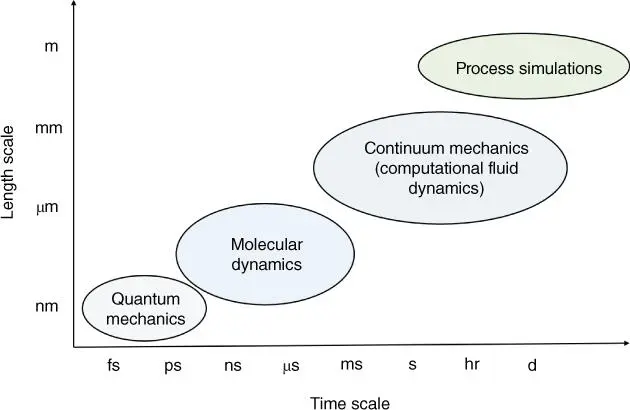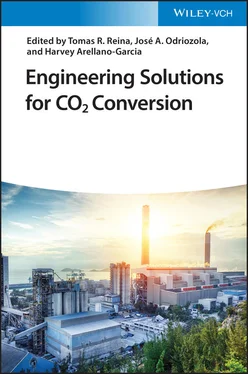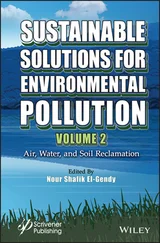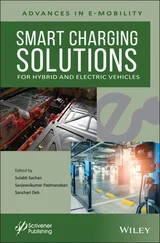62 62 Montañés, R.M., Flø, N.E., Dutta, R. et al. (2017). Dynamic process model development and validation with transient plant data collected from an MEA test campaign at the CO2 Technology Center Mongstad. Energy Procedia 114 (1876): 1538–1550.
63 63 Panahi, M. and Skogestad, S. (2012). Economically efficient operation of CO2 capturing process. Part II. Design of control layer. Chem. Eng. Process. Process Intensif. 52: 112–124.
64 64 Marx‐Schubach, T. and Schmitz, G. (2018). Dynamic simulation and investigation of the startup process of a postcombustion‐capture plant. Ind. Eng. Chem. Res. 57 (49): 16751–16762.
65 65 Martinez Castilla, G., Biermann, M., Montañés, R.M. et al. (2019). Integrating carbon capture into an industrial combined‐heat‐and‐power plant: performance with hourly and seasonal load changes. Int. J. Greenhouse Gas Control 82: 192–203.
66 66 Mechleri, E., Fennell, P.S., and Mac Dowell, N. (2017). Optimisation and evaluation of flexible operation strategies for coal‐ and gas‐CCS power stations with a multi‐period design approach. Int. J. Greenhouse Gas Control 59: 24–39.
67 67 IEAGHG (2013). Iron and Steel CCS Study (techn‐economics integrated steel mill). Report 2013/04.
68 68 IEAGHG (2013). Deployment of CCS in the cement industry, 2013/19.
69 69 CEMCAP (2018). D 4.6 – Comparative techno‐economic analysis of CO2 capture in cement plants, Deliverable 4.6, 2018.
70 70 Skagestad, R., Normann, F., Garðarsdóttir, S.Ó. et al. (2017). CO2 stCap – cutting cost of CO2 capture in process industry. Energy Procedia 114 (1876): 6303–6315.
71 71 IEAGHG (2018). Cost of CO2 capture in the industrial sector: cement and iron and steel industries, 2018/03.
72 72 Jansen, D., Gazzani, M., Manzolini, G. et al. (2015). Pre‐combustion CO2 capture. Int. J. Greenhouse Gas Control 40: 167–187.
73 73 Rackley, S.A. (2009). Carbon Capture and Storage. Butterworth‐Heinemann.
74 74 IEA. CO2 Capture and Storage: A Key Carbon Abatement Option. Paris: OECD Publishing.
75 75 Mathias, P.M., Reddy, S., Smith, A., and Afshar, K. (2013). A guide to evaluate solvents and processes for post‐combustion CO2 capture. Energy Procedia 37: 1863–1870.
76 76 Kvamsdal, H.M., Ehlers, S., Kather, A. et al. (2016). Optimizing integrated reference cases in the OCTAVIUS project. Int. J. Greenhouse Gas Control 50: 23–36.
1 1 https://www.iea.org/etp/explore/(visited in January 2019).
2 2 Under specific arrangements.
3 3 The Global Status of CCS, GCCSI 2018 https://indd.adobe.com/view/2dab1be7-edd0-447d-b020-06242ea2cf3b.
4 4 http://www.cleanker.eu.
5 5 https://www.netl.doe.gov/project-information?p=FE0026580.
6 6 www.cleanker.eu.
7 7 https://3d-ccus.com/.
2 Advancing CCSU Technologies with Computational Fluid Dynamics (CFD): A Look at the Future by Linking CFD and Process Simulations
Daniel Sebastia‐Saez1, Evgenia Mechleri1, and Harvey Arellano‐García1
1University of Surrey, Department of Chemical and Process Engineering, GU2 7XH, Guildford, United Kingdom
2Brandenburgische Technische Universität Cottbus‐Senftenberg, LS Prozess‐ und Anlagentechnik, D‐03046, Cottbus, Germany
2.1 Sweep Across the General Simulation Techniques Available
The application of simulation techniques to the study of carbon capture, storage and utilization (CCSU) underpins significant advantages such as gaining detailed insight into the underlying phenomena and reducing the experimental load and its associated risks. Simulation methods of interest for CCSU applications include those dealing with quantum mechanics, molecular dynamics, continuum mechanics (computational fluid dynamics, also known as CFD), and process engineering simulations, each with different length and time scales as illustrated in Figure 2.1.
At the smallest time and length scales, quantum mechanics focuses on solving the equations of quantum theory, whereas molecular dynamics is based on the application of Newton's laws of motion to a limited set of molecules. Quantum mechanics and molecular dynamics thus provide information on the phenomena taking place at the subatomic and molecular level, respectively.
The application of quantum mechanics and molecular dynamics to the field of CCSU provides valuable data on fractional free volume (space between particles), diffusion coefficients, and a better understanding of the role of hydrogen bonds on the absorption of CO 2into amino acid ionic liquids (AAILs) [1]; the mechanism for carbon dioxide sequestration within porous rocks [2]; the study of the phase change mechanism of biphasic solvents for CO 2capture [3]; and the adsorption mechanism including selectivity of different gas molecules in porous matrices [4]. In conclusion, quantum mechanics and molecular dynamics provide a visualization of the diffusion and chemical bonding at the subatomic and molecular level and are of interest for the development and study of new solvents and solid sorbents and the evaluation of sequestering media both in terms of diffusion time and depth.
In some other instances, however, researchers might need to obtain a broader vision of the phenomena taking place at larger time and length scales. Having commented briefly on the capabilities of quantum mechanics and molecular dynamics, the next step toward greater length and time scales is given by the application of continuum mechanics, which assumes that matter is a continuum instead of being formed by discrete particles. There is thus a boundary in terms of length scale between the suitability of the use of molecular dynamics or continuum mechanics for a given problem. Generally speaking, continuum mechanics must be applied instead of molecular dynamics when the representative length scale of the phenomenon to be studied is greater than the mean free path of the particles; that is, when the length scale contains a large number of particles. The Knudsen number  , where λ is the mean free path and L the length scale of the problem, gives a rule of thumb as to when to apply either methodology, with continuum mechanics being applicable when Kn < 1. Continuum mechanics is of interest for the study of the unit operations within a CCSU process. For instance, it is useful when the modeler needs to perform a preliminary proof of concept of a packed bed column or an oxy‐fuel burner and needs to represent its entire geometry. In some applications, however, it is unfeasible to perform a continuum mechanics simulation of the entire unit process, and thus, a multi‐scale approach might be necessary owing to computational capacity limitations. This becomes clear for the case of packed bed columns, where the intricate geometry requires the use of different scales depending on the variable to be studied.
, where λ is the mean free path and L the length scale of the problem, gives a rule of thumb as to when to apply either methodology, with continuum mechanics being applicable when Kn < 1. Continuum mechanics is of interest for the study of the unit operations within a CCSU process. For instance, it is useful when the modeler needs to perform a preliminary proof of concept of a packed bed column or an oxy‐fuel burner and needs to represent its entire geometry. In some applications, however, it is unfeasible to perform a continuum mechanics simulation of the entire unit process, and thus, a multi‐scale approach might be necessary owing to computational capacity limitations. This becomes clear for the case of packed bed columns, where the intricate geometry requires the use of different scales depending on the variable to be studied.

Figure 2.1Time and length scales of the simulation methods available for CCSU processes from quantum mechanics to molecular dynamics, continuum mechanics, and process engineering simulations.
The application of continuum mechanics to fluid flows gives way to the Navier–Stokes equations. As of today, the analytical solution of these equations is known only upon some restrictive assumptions, and therefore, numerical methods must be applied in the majority of cases of interest. The study of the numerical solving of the Navier–Stokes equations conforms the discipline known as computational fluid dynamics (CFD). Although historically the term CFD has referred to the numerical solving of the Navier–Stokes equations, it has been expanded recently to include the study and development of Lattice Boltzmann methods. The development of CFD kicked off within the field of aeronautics but has rapidly entered into other fields such as chemical engineering with the advent of increased computing power and refined algorithms capable of describing multiphase flows, chemical reactions, interface tracking, diffusion, etc.
Читать дальше

 , where λ is the mean free path and L the length scale of the problem, gives a rule of thumb as to when to apply either methodology, with continuum mechanics being applicable when Kn < 1. Continuum mechanics is of interest for the study of the unit operations within a CCSU process. For instance, it is useful when the modeler needs to perform a preliminary proof of concept of a packed bed column or an oxy‐fuel burner and needs to represent its entire geometry. In some applications, however, it is unfeasible to perform a continuum mechanics simulation of the entire unit process, and thus, a multi‐scale approach might be necessary owing to computational capacity limitations. This becomes clear for the case of packed bed columns, where the intricate geometry requires the use of different scales depending on the variable to be studied.
, where λ is the mean free path and L the length scale of the problem, gives a rule of thumb as to when to apply either methodology, with continuum mechanics being applicable when Kn < 1. Continuum mechanics is of interest for the study of the unit operations within a CCSU process. For instance, it is useful when the modeler needs to perform a preliminary proof of concept of a packed bed column or an oxy‐fuel burner and needs to represent its entire geometry. In some applications, however, it is unfeasible to perform a continuum mechanics simulation of the entire unit process, and thus, a multi‐scale approach might be necessary owing to computational capacity limitations. This becomes clear for the case of packed bed columns, where the intricate geometry requires the use of different scales depending on the variable to be studied.











